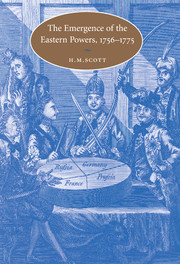Book contents
- Frontmatter
- Contents
- List of maps and genealogical table
- Acknowledgements
- A note on dates and place names
- List of abbreviations
- Introduction: the eighteenth-century European states system and its transformations
- 1 The rise of the eastern powers
- 2 The Seven Years War and the European states system
- 3 The domestic legacies of the Seven Years War
- 4 The stabilisation of Europe, 1763–1766
- 5 Diplomacy and the eastern powers
- 6 From peace to war, 1766–1768
- 7 The partition of Europe, 1768–1772
- 8 The advance of Russia, 1772–1775
- Conclusion: Russia and the emergence of the eastern powers
- Bibliography
- Index
- CAMBRIDGE STUDIES IN EARLY MODERN HISTORY
1 - The rise of the eastern powers
Published online by Cambridge University Press: 16 July 2009
- Frontmatter
- Contents
- List of maps and genealogical table
- Acknowledgements
- A note on dates and place names
- List of abbreviations
- Introduction: the eighteenth-century European states system and its transformations
- 1 The rise of the eastern powers
- 2 The Seven Years War and the European states system
- 3 The domestic legacies of the Seven Years War
- 4 The stabilisation of Europe, 1763–1766
- 5 Diplomacy and the eastern powers
- 6 From peace to war, 1766–1768
- 7 The partition of Europe, 1768–1772
- 8 The advance of Russia, 1772–1775
- Conclusion: Russia and the emergence of the eastern powers
- Bibliography
- Index
- CAMBRIDGE STUDIES IN EARLY MODERN HISTORY
Summary
The political emergence of Austria, Russia and Prussia was part of a wider eighteenth-century evolution which discovered the region and established the idea of eastern Europe. At least since the Renaissance, the continent had been divided conceptually between south and north. During the age of the Enlightenment new fault lines became established, as ‘eastern’ and ‘western’ Europe were invented and so became the two areas which made up its land mass. Contemporaries simultaneously incorporated Russia into the new, though geographically imprecise, region designated as ‘eastern Europe’. The continental wars of 1756–63 and 1768–74 were important in establishing these new dispensations: exactly as they were to be for the emergence of the eastern powers. By drawing attention to the area and to the important political developments under way, these conflicts highlighted its importance for western Europeans. That emergence, however, was primarily based upon earlier internal and international developments in each of the states which rose so impressively during the third quarter of the eighteenth century.
The first to become a leading European power had been Austria. Unlike Russia and Prussia, who emerged as first-class states only during the decades examined in this book, the Habsburg Monarchy had been a great power in name, if not in fact, since around 1700. This political emergence had always rested on a fragile domestic base. It was not that the extensive though far-flung territories ruled from Vienna were lacking in resources, particularly when compared with the other eastern powers.
- Type
- Chapter
- Information
- The Emergence of the Eastern Powers, 1756–1775 , pp. 11 - 31Publisher: Cambridge University PressPrint publication year: 2001

